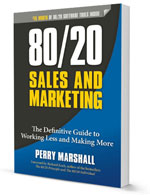Today’s lesson is very simple. It’s immediately applicable. And it’s extremely profitable.
It applies whether you run a business, or you consult with others.
When it’s applied, it could easily increase your per-customer value — on both first-time and past customers — by 25%. It’s quite possible that it could increase it by 100% or more.
What this means is that with this one simple lesson, you could double profits — without spending another dollar on advertising, or attracting any more new customers.
Did I tell you it’s simple?
And yet, surprisingly few businesses implement this today — even when its value has been proven over and over and over again.
In the mid 1970s, McDonald’s brought in some marketing number crunchers…
They tore into the numbers of one particular franchise owner’s 10 restaurants. They did an analysis on the comparative sales of all the different items on the menu.
And they found an anomaly.
You see, French fries were one of McDonald’s most popular menu items. And yet, on average, there were 200 customers every day at every McDonald’s location that did not order French fries.
Since French fries were so popular, and would compliment nearly any other order, they wondered if there was anything that could be done to increase sales.
The phrase that changed an industry was born…
“Would you like fries with that?”
Cashiers would now ask it after every sandwich order. A minor change, with major implications.
Suddenly, half the people who hadn’t been ordering fries, were.
This franchisee, across ten locations, started selling 100 more orders of fries per day, at $.60 apiece. Only $60 per day, per location, but the total for the year was $21,840. Across all 10 locations, it was nearly a quarter of a million dollars difference — $218,840 in increased sales.
The test was — obviously — a success. McDonald’s rolled it out across all franchises.
Before long, they applied the same principle to meals. If someone is going to come in for a meal, why not offer it as a single menu item?
Again, a minor change…
“Would you like that in a value meal?”
Major implications.
Today, a Quarter Pounder with Cheese runs about $2.29, according to a menu I found online (I haven’t actually been in years). A Quarter Pounder with Cheese meal though, $3.99.
That’s only 75% more revenue, but you can bet that the profit on the soda and fries are substantially higher than the profit on the burger. The value meal probably raises per-diner profit by 100% or more.
And what happens when the customer “Super-Sizes it”? (Another minor question with major implications.)
The price goes up to $5.99 — 161% more revenue than the sandwich alone, and probably…
A good 300-500% higher profits!
I said this is incredibly simple. And incredibly valuable!
Simply find out what your customers are most likely to want to purchase with what they’re already purchasing — and offer it to them!
Offline, in-person, in brick-and-mortar stores, you likely have to offer it before they order. You don’t want to be running a bunch of transactions for the same customer.
Online, it’s a bit different. Especially with information products.
Yes, you can offer in-cart upsells, that offer to add a complimentary item to their cart. Or you could do what Amazon does in no less than four places on their product pages — offer the complimentary item alongside the item folks came for in the first place.
Or, you can do what’s become the coup d’etat of the information marketing world.
It’s called the “one-click upsell.”
Basically, as soon as someone orders one product, immediately offer them a complimentary product, on the thank you page for the first product.
Most major shopping cart platforms have this built-in these days.
They just said yes to the first purchase, they’re actually more likely in this moment to want something else from you than they ever will be again (short of ordering again).
So put a single-click button in front of them that allows you to add the additional item to their order.
If applicable, have a string of 3, 4, 5 or more of these. Folks can always say no, and close out.
But those who say yes — often somewhere around 20-60% of the original purchasers — will significantly add to your profits and per-customer value, at pretty much zero additional expense.
Yours for bigger breakthroughs,
Roy Furr
Editor, Breakthrough Marketing Secrets




